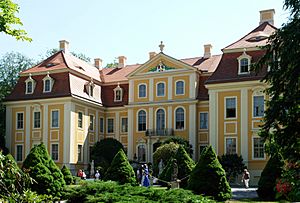Rammenau facts for kids
Quick facts for kids
Rammenau
|
|
|---|---|

Rammenau Castle, front side
|
|
| Country | Germany |
| State | Saxony |
| District | Bautzen |
| Municipal assoc. | Bischofswerda |
| Elevation | 296 m (971 ft) |
| Population
(2022-12-31)
|
|
| • Total | 1,340 |
| Time zone | CET/CEST (UTC+1/+2) |
| Postal codes |
01877
|
| Dialling codes | 03594 |
| Vehicle registration | BZ, BIW, HY, KM |
| Website | www.rammenau.de |
Rammenau (German name; Upper Sorbian name: Ramnow) is a small town, also called a municipality, in the Bautzen district of Saxony, Germany. It is known for being the birthplace of a very important German thinker, Johann Gottlieb Fichte.
Contents
Johann Gottlieb Fichte: A Famous Thinker
Rammenau is famous because it is the hometown of Johann Gottlieb Fichte (1762–1814). He was a well-known German philosopher. A philosopher is someone who studies big ideas about life, knowledge, and how we should live. Fichte's ideas were very important in his time and still influence thinkers today.
Rammenau Castle: A Grand Building
One of the most impressive places in Rammenau is its beautiful castle. This castle was built a long time ago, between 1721 and 1735.
Building the Castle
The castle was designed by a famous architect named Johann Christoph Knöffel. It was built for a man named Ernst Ferdinand von Knoch. He was a chamberlain for King Augustus II the Strong. A chamberlain was an important official who managed the king's household.
Changes in Ownership
Building such a grand castle was very expensive. Ernst Ferdinand von Knoch spent so much money that he went bankrupt. This meant he could no longer pay his debts. So, in 1744, the castle was sold at an auction to Franz Josef von Hoffmann.
Later, in 1879, the castle was sold again to the von Posern family. The last owner from this family was Margarete von Helldorff. In 1945, her family lost the castle when the communists took control of the area.
The Castle Today
Today, Rammenau Castle is owned by the State Palaces, Castles and Gardens of Saxony. This organization takes care of many historical buildings in Saxony. The castle is now open to the public. You can visit it and see a museum inside. The museum shows what the rooms looked like long ago, with furniture from that time.
See also
 In Spanish: Rammenau para niños
In Spanish: Rammenau para niños






